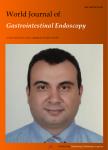Prevalence and clinical features of colonic diverticulosis in a Middle Eastern population
Prevalence and clinical features of colonic diverticulosis in a Middle Eastern population作者机构:Division of Gastroenterology Department of Medicine King Khalid University Hospital King Saud University Division of Gastroenterology the McGill University Health Center Montreal General Hospital McGill University
出 版 物:《World Journal of Gastrointestinal Endoscopy》 (世界胃肠内镜杂志(英文版)(电子版))
年 卷 期:2013年第5卷第8期
页 面:391-397页
学科分类:1002[医学-临床医学] 100201[医学-内科学(含:心血管病、血液病、呼吸系病、消化系病、内分泌与代谢病、肾病、风湿病、传染病)] 10[医学]
基 金:Supported by King Saud University for its funding of this research through the Research Group Project No. RGP-VPP-279
主 题:Colonic diverticulosis Diverticular disease Saudi Arabia Prevalence Lower gastrointestinal bleeding Epidemiology
摘 要:AIM: To determine the prevalence, location, associations and clinical features of colonic-diverticulosis and its role as a cause of lower-gastroenterology-bleeding. METHODS: We retrospectively reviewed the medical records of 3649 consecutive patients who under-went a colonoscopy for all indications between 2007 and 2011 at King Khalid University Hospital, Riyadh, Saudi Arabia. The demographic data were collected retrospectively through the hospital s information system, electronic file system, endoscopic e-reports, and manual review of the files by two research assistants. The demographic information included the age, sex, comorbidities and indication for the colonoscopy. The association among colonic polyps, comorbidities and diverticular disease was also ***: A total of 270 patients out of 3649 were diagnosed with colonic diverticulosis, with a prevalence of 7.4%. The mean age was 60.82 years ± 0.833, (range 12-110). Females comprised 38.89% (95%CI: 33-44.7) of the study population. The major symp-toms were rectal bleeding in 33.6%, abdominal pain in 19.3%, constipation in 12.8% and anemia in 6%. Diverticula were predominantly left-sided (sigmoid and descending colon) in 62%, right-sided in 13% and in multiple locations in 25%. There was an association between the presence of diverticulosis and adenomatous polyps (Pvalue 0.001), hypertension (P-value 0.0001) and diabetes mellitus (P-value 0.0016). Diverticular disease was the second most common cause of lower gastrointestinal bleeding, in 33.6% (95%CI: 27.7-39.4), after internal hemor-rhoids, in 44.6% (95%CI: 40.3-48.9). On multivariable logistic regression, hypertension (OR = 2.30; 95%CI: 1.29-4.10), rectal bleeding (OR = 2.57; 95%CI: 1.50-4.38), and per year increment in age (OR = 1.05; 95%CI: 1.03-1.07) were associated with diverticulosis but not with bleeding diverticular disease. Limitations: A small proportion of the patients included had colo-noscopies performed as a screening ***



